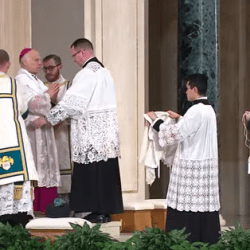A young woman approached me before mass on Palm Sunday to ask that question.
I replied, “Of course not. That’s fine.” She smiled sheepishly and said, “I know some priests don’t like it.” I reassured it that it was okay, and she later came to my communion station, knelt, and received on the tongue. It’s common practice at papal masses — Benedict has indicated he prefers to give communion that way — but in this country, it’s still somewhat rare.
Some background: the norm for reception of communion in the United States is standing. And, despite what others might be saying, the universal norm (and official teaching of the Church) from 2002 states no preference for kneeling or standing. This was underscored in Redemptionis Sacramentum:
“The faithful should receive Communion kneeling or standing, as the Conference of Bishops will have determined,” with its acts having received the recognitio of the Apostolic See.
Of course, many churches in the U.S. have done away with altar rails, making kneeling more difficult and standing more efficient.
But there’s no question: getting down on our knees adds reverence to the sacrament, and requires more thought, effort, sacrifice and, well, humility. In kneeling, we decrease so He may increase. (I also think kneeling inhibits liturgical abuse, like people just grabbing the host and wandering away without consuming it, or stuffing it in a handkerchief or pocket.)
While the pope has made clear what he prefers — and the Vatican has issued a statement to that effect — it remains to be seen if the Church will go one step further and make Benedict’s practice, by law, the practice of all the faithful.
Meantime, both forms of reception are valid. No one should have to ask permission to kneel, or make apologies for it — which is worth remembering as we approach tomorrow’s celebration of Holy Thursday, and the institution of the Eucharist.
UPDATE: A couple of readers have pointed out, correctly, that I failed to provide catechesis here (or in my initial encounter with the communicant) on just why standing is the norm in the United States, and why every communicant should conform to that norm.
Here’s how the USCCB explains it:
The General Instruction of the Roman Missal emphasizes that in matters of gesture and posture “greater attention needs to be paid to what is laid down by liturgical law and by the traditional practice of the Roman Rite, for the sake of the common spiritual good of the people of God rather than to personal inclination arbitrary choice” (Girm, no.42)/ Throughout their consideration of GIRM numbers 43 and 160, the Bishops repeatedly recalled the need for uniformity in all prescribed postures and gestures.
Such uniformity serves as a “sign of the unity of the members of the Christian community gathered for the sacred Liturgy” and it “both expresses and fosters the spiritual attitude of those assisting” (GIRM, no. 42). Likewise, a lack of uniformity can serve as a sign of disunity or even a sense of individualism. A particular example of this disunity has been cited by many of the Bishops in regard to a diversity of postures during the Eucharistic Prayer, “the center and summit of the entire celebration” (GIRM, no. 78). Thus, the variation from kneeling as the uniform posture during the Eucharistic Prayer is permitted only “on occasion” and when the circumstances found by GIRM (no. 43) are clearly present.
In describing the indispensable role of the gathered faithful at Mass, the General Instruction of the Roman Missal presents them as “a holy people, a chosen people, a royal priesthood” who “give thanks to God and offer the Victim not only through the hands of the priest but also together with him and learn to offer themselves” (GIRM, no. 95). Two responsibilities grow from this noble identity: “fostering of a deep sense of reverence for God as well as developing charity towards their brothers and sisters who share with them in the celebration” (GIRM, no. 95). Such a sense of reverence for God and charity for the other members of the liturgical assembly is concretely manifested by a unity in word, song, posture and gesture. Thus, this section concludes that the faithful are to shun any appearance of individualism or division, keeping before their eyes that they have the one Father in heaven and therefore are all brothers and sisters to each other” (GIRM, no. 95).
It could also be pointed out that standing for communion has remained the tradition of the Eastern Church for centuries, and undoubtedly harkens back to the very beginning of Christianity.
And, as another commenter noted, succinctly: “For centuries, reverence to the Eucharistic Presence of Christ was demonstrated throughout Europe and other parts of the world through a PROCESSION on Corpus Christi Sunday. We traditionally stand up to show reverence, and the act of solemn procession is every bit as reverent a gesture as the act of kneeling. Receiving communion is first a COMMUNAL act of the Church; kneeling in personal thanksgiving may be done after one returns to the pew.”












